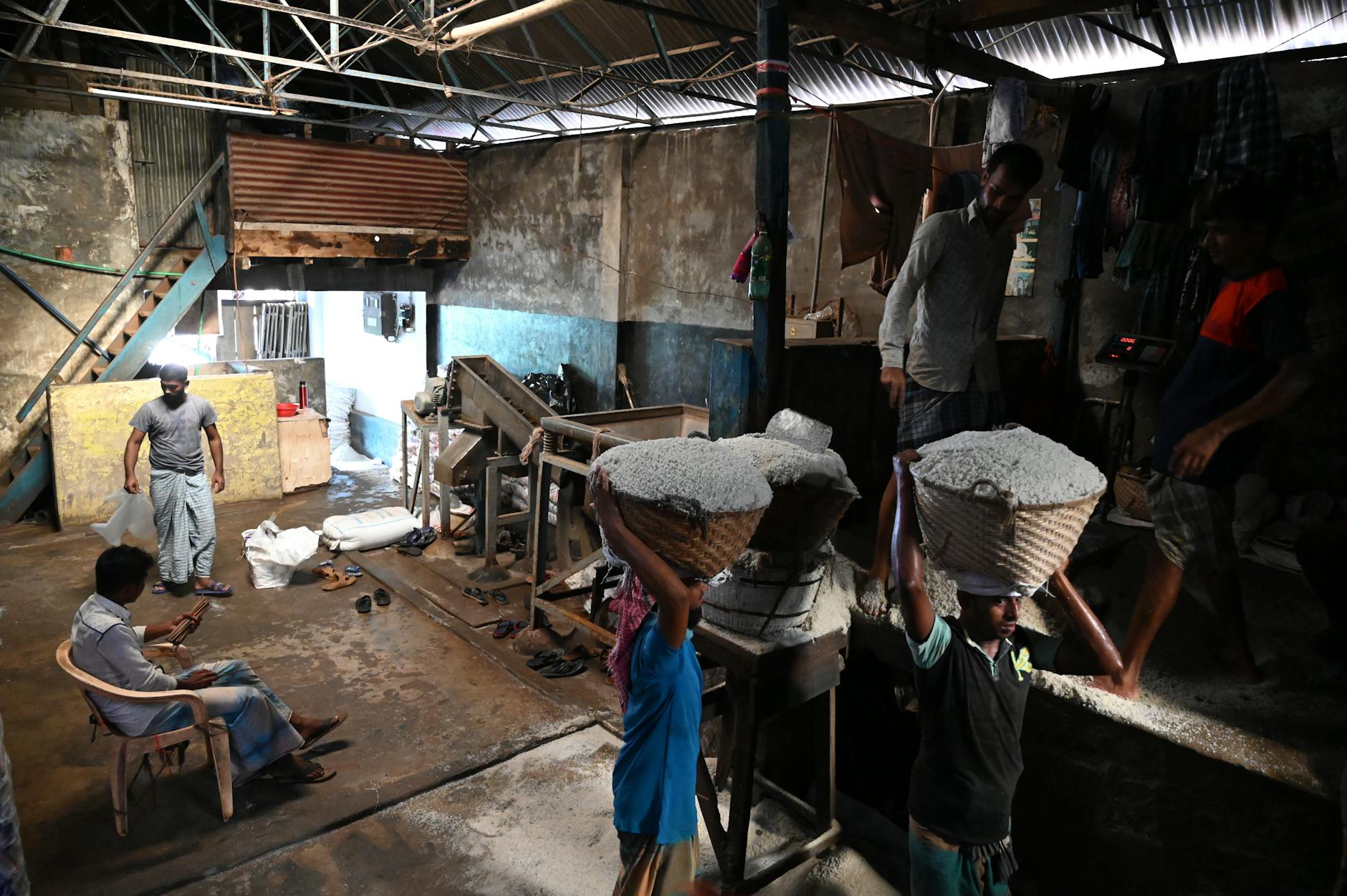The Catalyst: Internet Access in Developing Nations
Internet Access in Developing Nations
The Game-Changer: Internet’s Touch on the Job Market
Internet’s arrival on the labor scene in developing countries has set off a ripple effect of economic change and growth—offering fresh chances for go-getters and business owners alike.
How Women Fare Better: It’s been noticed that women seem to score better job outcomes when companies ramp up their tech game. Think of places like Vietnam, Brazil, and Nigeria—where the internet acts as a bridge over the gender gap in workspaces. When companies get online, the landscape shifts quite a bit, and women get a leg-up.
Learning New Tricks: Once hooked to the internet, companies in six African countries have been shelling out on-the-job training like never before. It all boils down to getting workers equipped with fresh skills, making them ready to hustle harder and smarter in the job market.
Here’s a quick look at how internet access changed the game for some African countries:
| Country | Before Internet Access | After Internet Access |
|---|---|---|
| Kenya | 12% | 25% |
| Ghana | 15% | 30% |
| Nigeria | 10% | 20% |
| Ethiopia | 8% | 18% |
| Tanzania | 13% | 27% |
| Uganda | 9% | 22% |
Ticking the Right Boxes with Internet Connectivity
Plugging into the internet brings a mix-bag of good stuff, especially for countries on the rise.
Boost in the Wallet: With roughly half the world online, it’s a big deal in places like Africa and South Asia, where a steady increase in internet access spells better pay and chances for many. In these areas, getting connected means getting control over personal and economic growth.
Diving into Data: On a global scale, there are 14 broadband subscriptions per 100 folks, telling of how internet reach has sky-rocketed. It uncorks endless opportunities in education, financial leaps, and job gigs.
| Region | Internet Users (%) |
|---|---|
| Africa | 34% |
| South Asia | 24% |
| Worldwide | ~50% |
| Broadband Subscriptions | 14 per 100 people |
New Doorways: With the internet in their corner, businesses aren’t just limited to local streets anymore—they’re setting eyes on the global stage. Digital platforms open fresh paths for marketing, sales spins, and how they chat up with their customers, driving a surge in economic scales and variety.
Riding the wave of internet connectivity can really bulk up job markets and spur economic growth in nations that are fast finding their feet. With the right push for more internet access, resolving the tech-divide and empowering people across the map becomes not just a goal but possible reality.
Economic Growth Opportunities
Internet’s Role in Market Expansion
Connecting the online world with local businesses in developing countries isn’t just a good idea; it’s a game-changer. Small to medium enterprises (SMEs) get a boost from being able to compete globally, all thanks to more internet access. Pushing policies that help close this digital divide is crucial to open doors to worldwide markets (IMF). Businesses start running smoother, reaching further, and getting stuff done more efficiently.
The Internet’s like magic for trade, pushing boundaries under everyone’s noses without stepping on a plane. In these growing regions, more people logging on equals more cash flow. Get this: If just 1% more folks in sub-Saharan Africa hop online, their wallet might fatten by 0.1 to 0.4% per person (IMF).
| Region | Boost in Internet Users (%) | Uplift in Per Capita Growth (%) |
|---|---|---|
| Sub-Saharan Africa | 1 | 0.1 – 0.4 |
When everyone plugs in, ideas fly; businesses get the latest tech tools. This means getting things done faster for less money, plus dreaming up new money-making ventures. Ladies, especially, find better job doors opening when this digital transformation takes shape, seen clearly in places like Vietnam, Brazil, and Nigeria (World Bank Blogs).
Increasing Access to Financial Products
Where there’s internet, there’s a way…to bank better, that is. The online world is revolutionizing access to financial goodies that seemed out of reach before. Imagine the digital bridge–it’s letting small businesses in on loans, insurance, and services that were once wishful thinking (IMF).
Here’s what financial products through the net can do:
- Tech investments go one step up.
- Transactions and payments become reliable and secure.
- More openings for saving cash and getting credit.
Supportive digital acts usher in a fairer financial world, empowering businesses and people. Companies in six African countries with decent WiFi are likelier to dish out hands-on learning on-site, helping employees upskill (World Bank Blogs).
The link between surf time and using financial tools is strong, highlighting why pumping resources into web tech matters. It’s not just about fatter wallets; it also breeds community mindsets and growth.
| Country | Online Participation (%) | Companies Providing Training (%) |
|---|---|---|
| Country A | 20 | 35 |
| Country B | 30 | 50 |
| Country C | 40 | 65 |
Throwing money into better web connections and teaching folks the ropes on digital use means major growth potential in these regions. It’s a chance for these nations to widen their markets and win in financial fairness for people across the board.
Overcoming Digital Disparities
Challenges in Digital Connectivity
Let’s chat about the whole digital divide thing—a fancy way of saying there’s a gap between folks who can surf the web and those still on the shores. This issue is not just about counting who has Wi-Fi or not, it hits hard, especially in places still catching up. Developing nations are facing roadblocks such as:
- Infrastructure Gaps: Imagine trying to stream your favorite show but there are no roads for your internet to travel. No fiber optic cables, no steady electricity; it’s like trying to build a sandcastle with no sand.
- Sky-High Costs: Getting online can cost an arm and a leg in these areas, putting it out of reach for many.
- Learning Curves: If connecting’s like unlocking a treasure chest, someone forgot to give the keys. Limited digital education means many can’t hop on the net effectively.
- Remote Locations: Think about folks living out in the boonies—many don’t have cell towers or internet lines nearby.
Let’s lay it out clear:
| Challenge | What’s Going On |
|---|---|
| Infrastructure Gaps | No fiber optic highways or power lines. |
| Sky-High Costs | Too expensive for both suppliers and users. |
| Learning Curves | Not enough teaching for online skills. |
| Remote Locations | Isolated areas with little to no service. |
The digital gap is like a stubborn stain on the shirt of progress, separating the haves from the have-nots, making it tough for tech-challenged places to get mini breakthroughs in learning and making money (IMF). Without a big push to level the playing field, these countries might stumble further behind (IEEE).
Closing the Global Internet Gap
So, how do we get everyone on the world’s biggest digital playground? It’s the need of the hour to close this connectivity canyon, not just for the sake of it, but for giving a fair shake at growth and opportunity. Here’s how:
- Build It and They Will Come: Developing nations need shiny new pipes and wires, and a sprinkle of electricity, to get things moving.
- Make It Cheap: Snip off a chunk of those costs so more folks can get a foot in the cyber door.
- Teach and Preach Online Skills: Roll out the red carpet for digital learning so everyone can ride the online wave.
- Team Up for a Win: Governments and companies should hang out together to whip up some genius ways to get everyone online.
Just putting it out here:
| Initiative | What’s the Move |
|---|---|
| Build It and They Will Come | Set up networks and power sources. |
| Make It Cheap | Cut down prices for users. |
| Teach and Preach Online Skills | Start digital courses. |
| Team Up for a Win | Join forces for solutions. |
Getting more people hooked to the internet isn’t just for fun, it’s fuel for the economic engine. Every 1% more of internet users could boost how much money people make by 0.1–0.4% in places like sub-Saharan Africa (IMF).
Global teamwork is essential to make tech wins possible and to make sure no country is left out of the internet’s perks (United Nations). By tackling these digital blockers, these nations can jump on board the digital express, avoiding the fate of sitting out the progress party.
Success Stories in Closing the Divide
South Korea’s Tech Drive
South Korea’s journey into the tech scene is a lesson in playing the long game with education and smart financing. Back during the third industrial boom, they decided to pour resources into technology and learning. And let’s just say, it’s paid off big time. Because of this strategy, they’ve closed the digital gap like champs (IEEE).
With these moves, South Korea now boasts a higher GDP per person than some countries in the European Union. This shows just how game-changing tech investments can be for a country’s economy.
What they got right:
- They made sure everyone had access to fast internet.
- They spent wisely on tech-based education.
- They pushed for more Science, Tech, Engineering, and Math lessons in schools.
What this has done is make sure that almost everyone has a ticket to the digital party, letting folks dive into all the goodies the internet brings.
| Indicator | South Korea | European Union Average |
|---|---|---|
| GDP per capita | Higher | Lower |
| Internet Penetration Rate | 95% | 90% |
| Public Expenditure on Education | 5.9% of GDP | 4.7% of GDP |
Leveling the Playing Field in Education
South Korea hasn’t just stopped at building a digital paradise; they’ve also been crushing it in making sure no one gets left out when it comes to education. The government there has rolled out loads of projects that make sure everyone, no matter where they are, can hop online and learn. By keeping an eye on inclusion, they’re leveling the playing field for all students.
Major moves include:
- Online Learning Platforms: Setting up solid online learning systems for kids in remote spots.
- Affordable Internet Plans: Helping families on tight budgets get online without breaking the bank.
- Techy Classroom Courses: Making sure school lessons are packed with tech to get kids ready for tomorrow.
These efforts have not only improved learning but also boosted students’ digital know-how. It means every kid, rich or poor, can ride the wave of the digital age.
| Initiative | Impact |
|---|---|
| Online Learning Platforms | More students getting good education |
| Affordable Internet Plans | Wider internet access in poorer areas |
| Techy Classroom Courses | Better tech skills and future-proofing |
South Korea’s approach is a great playbook for countries intending to use the internet to bridge the digital divide, ensuring everyone feels the perks of being connected.
Initiatives and Collaborations
Global Efforts for Internet Inclusion
In a bid to shrink the digital gap, a bunch of global initiatives are on the move to make internet access widespread, especially in developing nations. The World Bank has its hands deep in several key projects.
-
World Bank Digital Development Programs: They’re all about getting everyone connected to a fast, reliable, and affordable internet. Think broadband boost, teaching folks the ABCs of digital stuff, and making sure devices to get online are easy to snag. (World Bank)
-
Digital Data Infrastructure Initiative: Aiming to wring every bit of social and economic value out of data in developing regions, this plan pushes for investment in data tech and infrastructure, beefs up data governance, and gets data management systems talking to each other. (World Bank)
-
Digital Economy for South Asia (DE4SA): Dialed into checking the pulse of the digital economy across South Asia, this initiative is big on making sure folks can join the digital party, building circles of trust, and building up the muscle to make the most of the digital economy while dodging its downsides. (World Bank)
Not to be left behind, big tech companies are jumping on the global internet bandwagon too:
-
Google Alphabet’s Project Loon: It’s all about floating those high-flying balloons to beam down internet to folks everywhere. (The Borgen Project)
-
Facebook’s Connectivity Labs: These guys are tinkering with cool tech like super-high aircraft and satellites to get the internet flowing everywhere. (The Borgen Project)
-
Microsoft’s Affordable Access Initiative: The name says it all—they’re working on keeping the internet budget-friendly for communities that really need it. (The Borgen Project)
Legislative steps are also in the mix, like the Digital Gap Act backed by the U.S. House of Representatives, aiming to ramp up internet access globally, spotlighting areas like rural farming communities and women. (The Borgen Project)
Company Initiatives for Connectivity
Moving to individual companies, they’re each throwing in their own methods to punch up internet access in developing spots. Each with its own spin on narrowing down the connectivity void.
-
Google’s Project Loon: Mentioned again, this initiative sends up balloons into the sky to craft a floating wireless network, bringing internet to the far-flung and underserved corners.
-
Facebook’s Connectivity Initiatives: From solar drones (Aquila) to satellite wizardry, they’re about getting high-speed internet zipping across the globe.
-
Microsoft’s Affordable Access Initiative: This idea zeroes in on fresh, scalable, and cost-effective internet solutions, with a focus on teaming up with local go-getters and businesses to lay down sustainable paths.
| Company | Initiative | Technology Used |
|---|---|---|
| Google Alphabet | Project Loon | Big sky balloons |
| Connectivity Labs | High-flyers, drones, satellites | |
| Microsoft | Affordable Access Initiative | Scalable and wallet-friendly internet fixes |
These combined efforts show how both global and company efforts form the backbone of better internet access in developing areas, paving the way for an economic boost and a lift in living standards.
Emerging Trends in Technology
IoT and Business Optimization
The Internet of Things (IoT) is making a huge splash across various industries, shaking things up with gadgets like wearables and sensors to help businesses score big with results. With the turbo-charged speed of 5G, more of these IoT gadgets are popping up, especially in places like healthcare, manufacturing, and logistics (CompTIA).
How IoT is Used in Key Areas:
- Healthcare: Gadgets such as remote monitoring tools and wearable health trackers are great for keeping tabs on patients and crunching data in real-time.
- Manufacturing: Sensors keep a lookout for machine hiccups, cutting down on downtime and revving up production.
- Logistics: IoT gadgets provide real-time tracking for shipments, making supply chains run like a well-oiled machine.
Why IoT Rocks:
- Boosts Efficiency: With IoT handling the behind-the-scenes stuff, businesses can bump up productivity.
- Smart Decisions: Real-time data helps steer the ship when it comes to making business choices.
- Resource Management: IoT keeps a watchful eye on resources, making sure they’re used wisely and sustainably.
| Industry | Regular IoT Use | What It Brings to the Table |
|---|---|---|
| Healthcare | Remote Monitoring, Wearables | Keeps patient data updated, improves health management |
| Manufacturing | Predictive Maintenance, Sensors | Less breakdowns, more productivity |
| Logistics | Shipment Tracking | Smoothes out supply chain, delivers real-time updates |
Advancements in Data Security
As more IoT devices hit the scene, beefing up cybersecurity is a must. Homomorphic encryption is one exciting stride ahead—letting folks process data while it’s still under lock and key. It keeps the bad guys out while keeping businesses running smoothly (CompTIA).
Top Security Tech Innovations:
- Homomorphic Encryption: Works magic on data without spilling the secret sauce, keeping it private and compliant.
- Standalone 5G Networks (5G SA): Boosts both reach and speed—perfect for stuff like driverless cars and cutting-edge robots.
- Edge Computing: Crunches numbers right where they’re made, speeding things up and reducing delays, especially in healthcare and manufacturing.
Perks of Zippy Data Security:
- Better Privacy: Keeps info under wraps during processing with homomorphic encryption.
- Efficient Ops: 5G SA and edge computing slash wait times, making data processing a breeze.
- Rules & Regs Ready: Security tech keeps you on the right side of data protection laws.
| Security Innovation | Where It’s Handy | Why It’s Awesome |
|---|---|---|
| Homomorphic Encryption | Data Privacy and Compliance | Processes data secretly, checks the compliance box |
| Standalone 5G Networks | Autonomous rides, high-tech robots | Expands coverage, speeds up data |
| Edge Computing | Real-time Crunching in Healthcare, Manufacturing | Cuts delay, speeds up operations |
The ongoing tech revolution with IoT and fresh security advancements are game-changers for folks in developing corners of the globe. They optimize how businesses work and protect data, paving the way for economic and tech growth.













